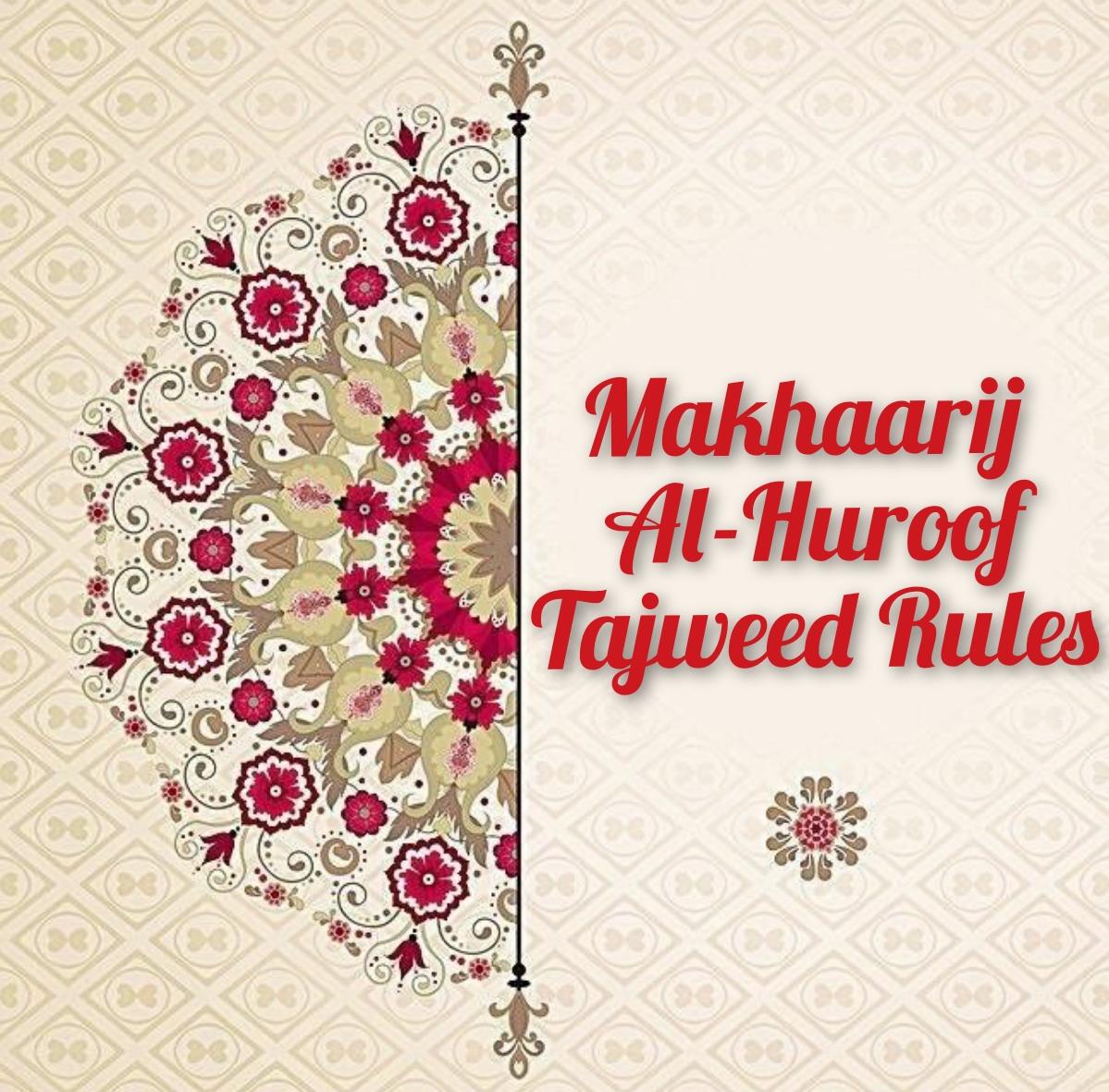Makhaarij Al-Huroof
Makharij means the place of emitting the letter when pronouncing it that differentiates that specific letter from other letters, but The letter is a sound that relies on a specific or approximate articulation point. The scholars laid out five major areas that have within them the different articulation points, which are a total of 17. The five main Makharij are:Al-Jawf, Al-Halq, Al-Lisaan, Ash-Shafataan, and Al-Khayshoom.The first Makhraj:Al jawf
Al-Jawf is the empty space in the mouth and throat is a place and an articulation point at the same time. The three medd letters originate from this non-specific area, these letters are: Alif ( ا ) preceded by a fat-ha, pronounced “aaa” Yaa ( ي ) preceded by a kasra, pronounced “eee” Waaw ( و ) preceded by a dammah, pronounced “ooo” These three letters are usually called Huroof Al-Maddeeyah and also be called Huroof Al-Jawfeeyah.This is illustrated in the following diagram:

The second Makhraj:Al-Halq
Al-Halq means the throat which has three articulation points for six different letters.These three Makharij are:
1- The deepest part of the throat- Aqsal-halq.
2- The middle of the throat- Wasat Al-halq.
3- The closest part of the throat- Adnal-halq.
This is illustrated in the following diagram:

 2-The Mid-Throat – Wasat Al-halq :
The mid-throat produces two letters:
Haa’ ( ح ), pronounced “hh“.
‘Ayn ( ع ), pronounced ” ‘a “.
2-The Mid-Throat – Wasat Al-halq :
The mid-throat produces two letters:
Haa’ ( ح ), pronounced “hh“.
‘Ayn ( ع ), pronounced ” ‘a “.
 3- The Upper Throat – Adnal-halq :
The upper throat produces two letters:
Khaa’ ( خ ), pronounced “kh”.
Gyan ( غ ), pronounced “gh”.
3- The Upper Throat – Adnal-halq :
The upper throat produces two letters:
Khaa’ ( خ ), pronounced “kh”.
Gyan ( غ ), pronounced “gh”.
 The third Makhraj: Al-Lisaan
It has ten articulation points for eighteen letters. These ten articulation points are:
1-The deepest part of the tongue– Aqsal-lisaan.
2- The middle of the tongue– Wasat Al-lisaan.
3- The edge of the tongue– Haafat Al-lisaan.
4- The tip of the tongue– Tarful-lisaan.
1-The deepest part of the tongue- Aqsal-lisaan:
from the upper (soft) palate produces two letters:
1- Qaaf ( ق ), pronounced “qq”
The third Makhraj: Al-Lisaan
It has ten articulation points for eighteen letters. These ten articulation points are:
1-The deepest part of the tongue– Aqsal-lisaan.
2- The middle of the tongue– Wasat Al-lisaan.
3- The edge of the tongue– Haafat Al-lisaan.
4- The tip of the tongue– Tarful-lisaan.
1-The deepest part of the tongue- Aqsal-lisaan:
from the upper (soft) palate produces two letters:
1- Qaaf ( ق ), pronounced “qq”
 2- Kaaf ( ك ), pronounced “kk”
2- Kaaf ( ك ), pronounced “kk”
 2- The middle of the tongue- Wasat Al-lisaan:
from the hard palate produces 3 letters:
Jeem ( ج ), pronounced “jj”.
Sheen ( ش ), pronounced “shh”.
Consonant yaa ( ي ), pronounced “ya” or “yi” or “yu” or “y”.
2- The middle of the tongue- Wasat Al-lisaan:
from the hard palate produces 3 letters:
Jeem ( ج ), pronounced “jj”.
Sheen ( ش ), pronounced “shh”.
Consonant yaa ( ي ), pronounced “ya” or “yi” or “yu” or “y”.
 3- The edge of the tongue- Haafat Al-lisaan:
From the side of the tongue produces two articulation points for two letters:
Daad ( ض ), pronounced “dd“.
Laam ( ل ), pronounced “ll”.
3- The edge of the tongue- Haafat Al-lisaan:
From the side of the tongue produces two articulation points for two letters:
Daad ( ض ), pronounced “dd“.
Laam ( ل ), pronounced “ll”.
 4- The tip of the tongue- Tarful-lisaan:
from the hard palate, behind the two front teeth produces the letter:
Noon ( ن ), pronounced “nn”.
from the upper tip (tarful-lisaan), are pushed off the hard palate, the letter:
Raa’ ( ر ), pronounced “rr”.
4- The tip of the tongue- Tarful-lisaan:
from the hard palate, behind the two front teeth produces the letter:
Noon ( ن ), pronounced “nn”.
from the upper tip (tarful-lisaan), are pushed off the hard palate, the letter:
Raa’ ( ر ), pronounced “rr”.
 Between the upper tip and hard palate, directly behind the two front incisors, the following letters are produced:
Taa’ ( ط ), pronounced “tt“.
Taa’ ( ت ), pronounced “tt”.
Daal ( د ), pronounced “dd”.
Between the upper tip and hard palate, directly behind the two front incisors, the following letters are produced:
Taa’ ( ط ), pronounced “tt“.
Taa’ ( ت ), pronounced “tt”.
Daal ( د ), pronounced “dd”.

Between the top and bottom teeth is an open area which is generally known to make a hissing sound. With the tip of the tongue, this area is also the makhraj for:
Saad ( ص ), pronounced “ss“ Seen ( س ), pronounced “ss” Zay ( ز ), pronounced “zz” Between the very tip of the tongue and the bottom edge of the two front teeth, the following letters are produced
Thaa’ ( ث ), pronounced “thh”
Thaal ( ذ ), pronounced “th”
Thaa’ ( ظ ), pronounced “th“
Between the very tip of the tongue and the bottom edge of the two front teeth, the following letters are produced
Thaa’ ( ث ), pronounced “thh”
Thaal ( ذ ), pronounced “th”
Thaa’ ( ظ ), pronounced “th“
 The fourth Makhraj: Ash-Shafataan
Ash-Shafataan: the lips are the makhraj for four letters. There are two main areas within this makhraj; they are as follows:
Baa’ ( ب ), pronounced “bb”
Meem ( م ), pronounced “mm”
Consonant waaw ( و ), pronounced “wa” or “wi” or “wu” or “w”
Faa’ ( ف ), pronounced “ff”
The fourth Makhraj: Ash-Shafataan
Ash-Shafataan: the lips are the makhraj for four letters. There are two main areas within this makhraj; they are as follows:
Baa’ ( ب ), pronounced “bb”
Meem ( م ), pronounced “mm”
Consonant waaw ( و ), pronounced “wa” or “wi” or “wu” or “w”
Faa’ ( ف ), pronounced “ff”


The fifth makhraj: Al-Khayshoom
It is the hole in the nose that continues back towards the inside of the mouth. This is the place where the ghunnah comes from. The ghunnah is a characteristic of noon and meem that is especially prevalent when they have a shaddah on them.




